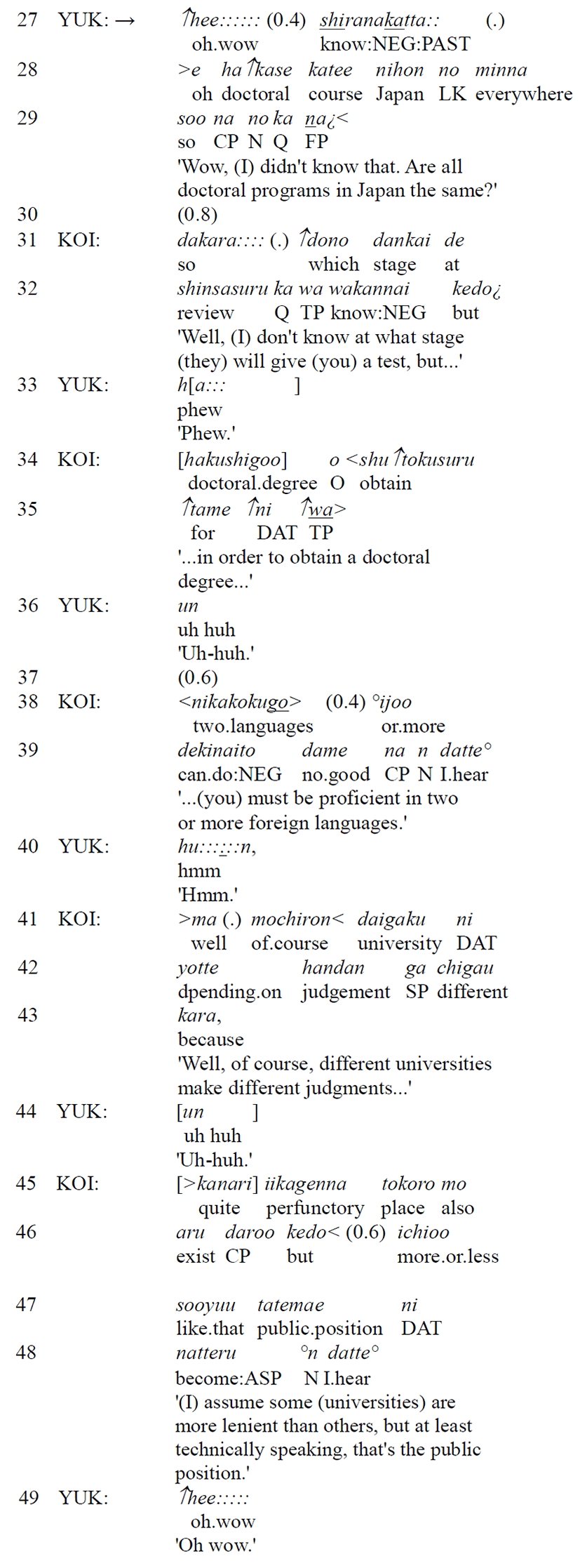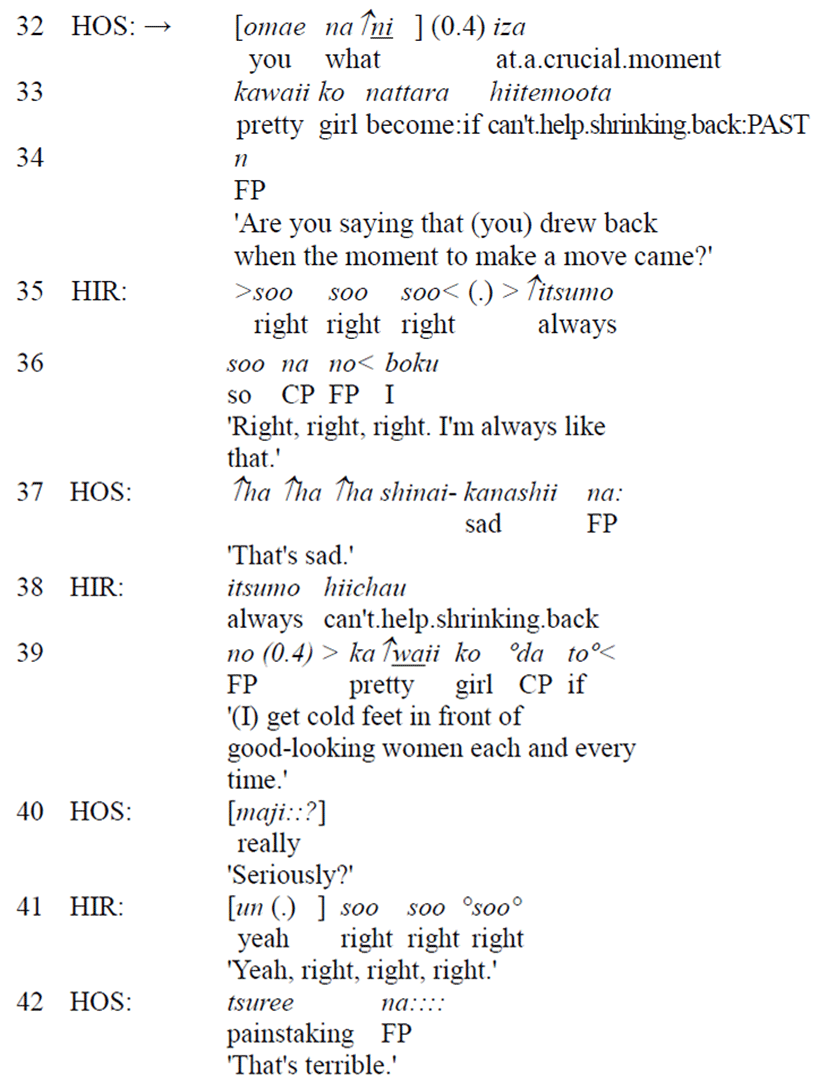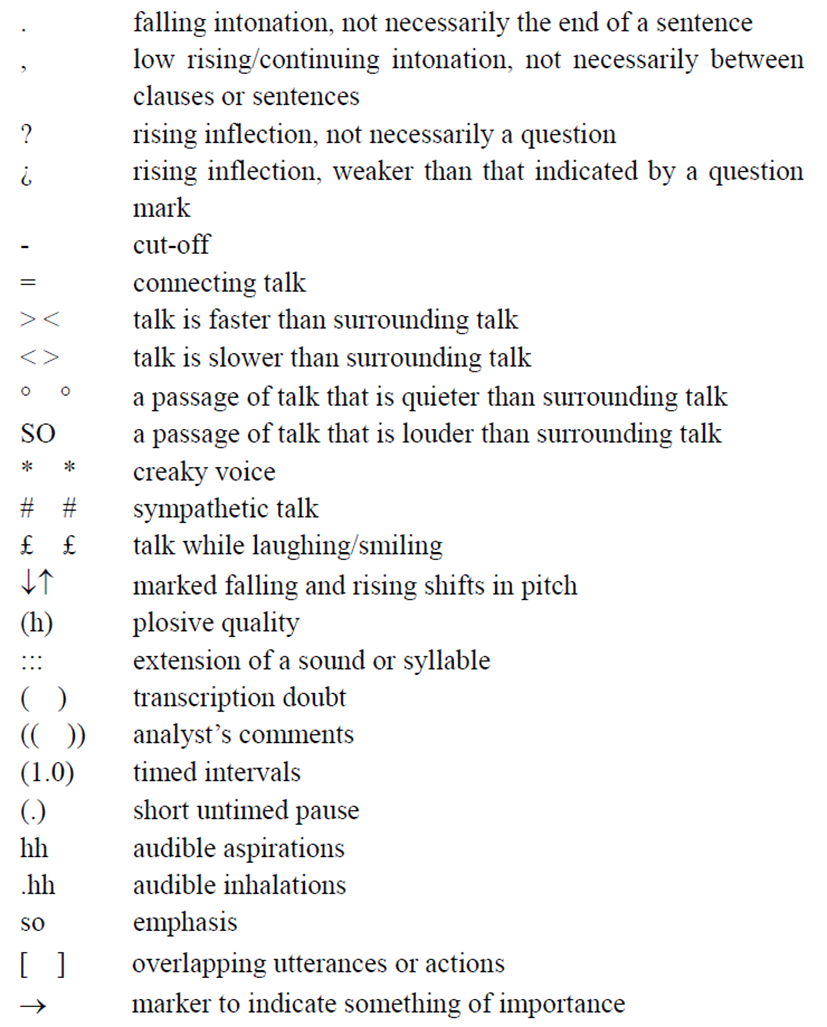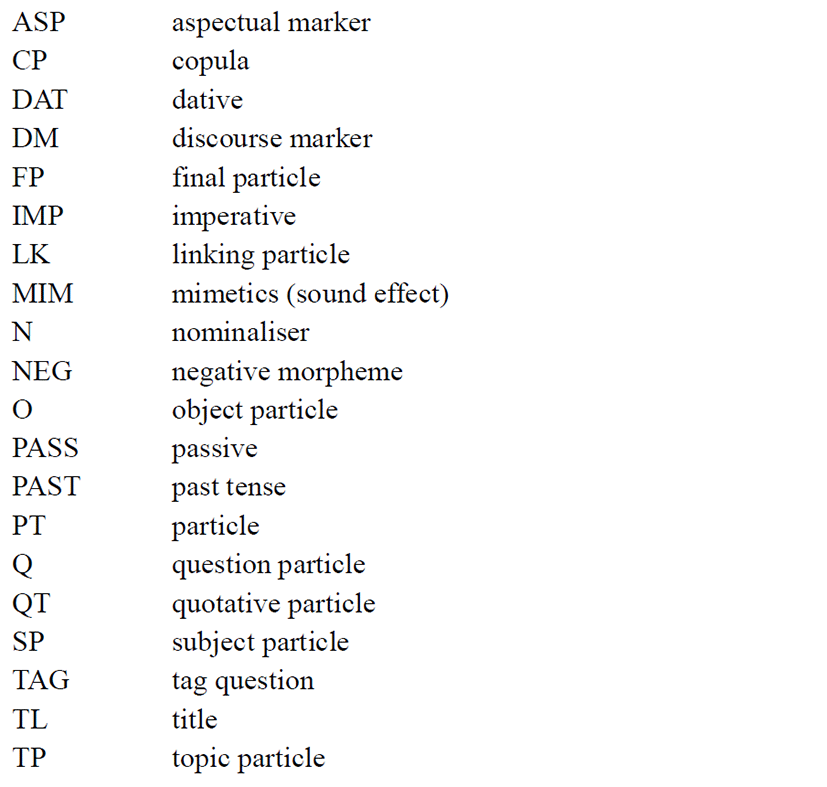1. Introduction
Listeners contribute as much as primary speakers do to ongoing conversations, not only through response tokens (Szczepek Reed & Persson 2016) such as continuers (e.g., “uh-huh”, “mm-hmm”) and assessments (e.g., “oh wow”, “God!”) but also through various interrogative formats for (1) initiating repair (Kendrick 2015), (2) formulating understandings (Weiste 2016), (3) seeking agreement (Sifianou 2012: 1561), and (4) soliciting elaboration (Schegloff 2007: 65). The present study examines the use of four types of questions—specifying, follow-up, leading, and summarizing with which listeners convey affect, appreciation, or judgment over the course of extended interactions in Japanese, from the perspective of conversation analysis (CA), with reference to the growing body of social interaction research from a comparative CA perspective.
Over the last thirty years, CA has been concerned with the underlying and possibly universal patterns that govern talk-in-interaction in an increasingly broad range of languages and communities (Stivers et al. 2009, Dingemanse, Torreira & Enfield 2013) and has determined that the turn-taking system (i.e., participants’ practice of taking turns) is universal while containing a degree of cross-cultural variations, e.g., in the length of the silence acceptable between turns (Knox 2011: 92). In other words, the turn-taking model is a universal system implemented with the local resources of a given language (Clift 2016: 32). Question-answer adjacency pair sequences are particularly interesting conversational objects because they show how participants achieve social cohesion in a wide range of circumstances. In light of the universal nature of asking questions, Ilie (2015) takes the view that greater emphasis and effort needs to be devoted to examining commonalities and differences regarding the assumptions, expectations, and implications triggered by the uses of language- and culture-specific question-answer practices in larger-scale studies of possibly larger data sets. The interactions reported here are intended to contribute to a deeper understanding of culturally appropriate ways of framing questions and to shed light on current developments in the areas of CA and cross-linguistic and cross-cultural studies.
2. Questions in Japanese Conversation
In a study of storytelling interactions, Koike (2009: 287) demonstrates that listeners provide not just aizuchi1. Through the practice of asking questions, listeners display what they have or have not understood in the story up to that point and also achieve mutual understanding, bridge the worlds of different participants in the conversation, provide different perspectives on the recounted events, and help the storyteller gain new insights into the events he/she is recounting. There are retrocessive questions, processive questions, side expansion questions, and playful joke questions (Koike 2009: 289) that serve to elicit, repair, forward, expand, and extend stories. Koike (2015: 506) further reports that listeners employ not only grammatical devices but also prosody and body movements to elicit factual information and the emotional states of the storyteller and to display their own affective stance toward the events the story reported.
Hayashi (2010: 2694-2701) assesses and interprets statistical results of the question-response system in spontaneous conversations. As for social action, requesting confirmation is the most common (49%), followed by requesting information (27%) and offering assessment/opinion while seeking agreement (15%). The high percentage of questions devoted to offering assessment/opinion while seeking agreement is due to the relatively high number of tag-type questions. Eight percent are classified as initiating repair. As for response fittedness, 61% of questions are responded to with answers. Eleven percent of all questions receive no responses, and there are a range of utterances produced after questions that are in response to the preceding question but that do not answer the question (i.e., requested information, including confirmation and agreement). Twenty-eight percent of the questions that make the provision of an answer relevant receive these nonanswer responses. Resistance to answering questions can be achieved by the use of iya (no), which alerts the questioner to the fact that the speaker finds some aspect of the preceding question problematic (Hayashi & Kushida 2013: 234).
Tanaka (2015) observes that questions are not always answered in informal conversations between friends. Questions are sometimes answered with questions or not answered at all. Yet the conversation continues without any sign from the participants that this is disruptive (ibid.: 127). There are several possible explanations for this type of pragmatic behavior. Questions between friends (1) are not used to obtain information but rather function as strategies to show interest and involvement in the interaction (ibid.: 129), (2) serve as maintenance work on the friendship (ibid.: 142), and (3) are used to express emotive states rather than to elicit referential meaning. All of this highlights the lack of correspondence between form and function in conversations between friends. Therefore, despite the fact that questions are not necessarily answered, the turn-taking mechanism operates properly and the conversation proceeds fluently (ibid.: 163).
Shigemitsu (2017) analyzes question-answer sequences in male initial meetings and argues that participants tend to use more yes/no questions and also prefer to ask about topics that are not related directly to the speaker. This is because many Japanese people believe that asking questions, especially detailed questions about personal opinions and ideas, is impolite (Shigemitsu 2015), although statistically, Japanese people use more questions in comparison to the three English-speaking countries (UK, USA, Australia) investigated in Shigemitsu’s study.
3. Method
This study is based on an audio corpus of six hours of recording collected in the Tokyo area. Two recorders (a Sony IC Recorder ICD-SX813 and an Olympus Voice-Trek DS-750) were placed in front of participants who were intimate friends having casual conversations in their homes, offices, or public areas. The author was not a participant in any of the conversations. The age range of the participants was between the ages of 21 and 54, and they spoke standard or a regional dialect of Japanese. The conversations were of a nontechnical nature, each ranging between eight and 25 minutes. The transcript is taken verbatim from the voice recording. The text is written in lowercase letters only, including proper nouns. Transcription conventions and a list of abbreviations used in the morphological glosses are included in the appendices.
4. Analysis
Selected excerpts from the transcripts illustrate analytical points extrapolated from the data set.
Excerpt 1 and Excerpt 2 are taken from the same conversation. Excerpt 1 is an example of a specifying question that foregrounds implicit information. The participants and the basics of the conversation are as follows: Koichi and Yuko are graduate students. In this segment, they talk about the language requirements for graduate school admissions.
Koichi explains that competence in two foreign languages is required to apply for admission to the graduate programs at Waseda University (lines 16-18). Koichi speaks quieter and with a falling intonation contour and makes his turn recognizably complete toward the end of his turn. Yuko produces a specifying question to help make abstract and general ideas more specific, trying to clarify what the test requirement actually is (Drew 1997: 76) hh ↑hee:::: .h e de↑kiru tte kaiwa toka mo <ke↓kkoo> (0.2) tsuka- (wow, does that mean [you] have to have sufficient conversational ability as well?) (lines 19-21). The turn initial response token hee (oh wow) (medium level of positive attribution) registers the achievement of epistemic coherence (Tanaka 2013)—that is, the newly received message coheres with her preexisting knowledge and experience, while the particle e (oh/what) is used to acknowledge that the information just received is new and/or unexpected (Couper-Kuhlen & Selting 2017: 525, Hayashi & Hayano 2018). Yuko is framing the newsworthiness of Koichi’s statement within her preexisting knowledge, contextualizing it in a wider interpretive framework. She is also telling him that what he has just said is causing her surprise and revelation.
Koichi preemptively responds to the question by saying >n soko made dekinakute ii n da kedo,< ([you] don’t need to be that good [at foreign languages], but) (lines 22-23). The unit-final marker kedo (but) (Mori 1999) provides a place for the listener to demonstrate their involvement in the conversation. Yuko utters a response token un (uh-huh) (line 24) at this interactionally relevant subunit boundary. Koichi continues with his turn in progress and completes it >nanrakano katachi de< ichioo shiken o ºshinaitoº ([they] have to give [you] a test in one form or another) (lines 25-26). The final to is a type of turn final design called ‘iikiri’ (truncated form) characterized by the absence of utterance-final objects to mark possible turn completion points (Tanaka 2004: 63-64).
Excerpt 2 shows that a follow-up question can engage the speaker on a more personal level and provide a new dimension to the story. Yuko enquires about whether the prerequisite for entrance into Koichi’s graduate programs applies to other universities.
Yuko utters a response token ↑hee:::::: (oh wow) (medium level of positive attribution) (line 27) with which she registers the achievement of epistemic coherence and follows it with an explicit newsmarker shiranakatta:: ([I] didn’t know that) (Mori 2006: 1201), a display of an utterance’s informative value. Yuko then produces a follow-up question >e ha↑kase katee nihon no minna soo na no ka na¿< (are all doctoral programs in Japan the same?) (lines 28-29) where the particle ka na at the utterance-final position serves to express some doubt or uncertainty, equivalent to “I wonder” (Curl & Drew 2008: 143). This question expands the conversation sideways rather than backward or forward and is designed to demonstrate that the listener is thinking about something mentioned in the previous turns. It also mitigates the directness of the inquiry and invites a response of either agreement or disagreement from the speaker—instead of just asking a standard interrogative, it encourages the speaker to ‘wonder’ a bit as well.
Koichi begins his answer turn with a relatively noncommittal response (Clayman 2002: 242, Stivers & Robinson 2006: 371, Stivers 2010: 2778) dakara:::: (.) ↑dono dankai de shinsasuru ka wa wakannai kedo¿ (well, [I] don’t know at what stage [they] will give [you] a test, but) (lines 31-32). The elongation of the discourse marker dakara (so / that is to say) indicates the unfavorable status of the turn but also the continuing willingness to provide an answer (Onodera 2004: 37). The unit-final marker kedo provides a place for Yuko to mark her recipiency. At this conversationally relevant subunit boundary (line 33), Yuko says ha::: (phew) (medium level of positive attribution). Koichi continues with his turn in progress hakushigoo o <shu↑tokusuru ↑tame ↑ni ↑wa> (in order to obtain a doctoral degree) (lines 34-35). He places emphasis on the binding particle wa, which is one of the resources used to elicit aizuchi from the listener. Yuko utters aizuchiun (uh-huh) at this subunit boundary (line 36). Koichi continues with his turn in progress and completes it <nikakokugo> (0.4) °ijoo dekinaito dame na n datte° ([you] must be proficient in two or more foreign languages) (lines 38-39).
Excerpt 3 and Excerpt 4 are taken from the same conversation. Excerpt 3 is a case of a leading question that is meant to steer the speaker in the direction the questioner wants. The participants and the basics of the conversation are as follows: Hiroki and Hoshoku are members of the same club at university. Hiroki talks about how a date that resulted from the personal ad went.
Hiroki describes his emotional state leading up to the climactic point chotto ne (.) a↑marini↓mo:::, °chotto:::° (.) k- kawaisugite:::, ano:::: (.) na↑ni-mo >dekinai,< ([she] was a little too pretty, so um [I] couldn’t do anything) (lines 13, 15, 17). Hoshoku’s ººmajiºº (seriously?) (line 19) registers disbelief, which seems to indicate that he is expressing incredulity, something along the lines of “Really? Well, you messed that up!” Hiroki summarizes the date by saying that they just had a meal at a restaurant tada gohan o::: tabete:: ([we] just had a meal) (line 20) and parted “jaa ne” ºtteº (.) sorekkiri ºtte yuu neº (and said “goodbye” and that was it) (lines 22-23). The final particle ne (Tanaka 2000: 18) at the end of the utterance marks a point of possible turn completion. Here Hoshoku produces a leading question aite tsumannasoo (did she look bored?) (line 24). This question puts the speaker on the spot. It is designed to highlight motivations of the characters that the speaker did not explicitly articulate. It is also intended to cement the story’s upshot and feed the speaker his lines.
The 0.6-second silence suggests that Hiroki is caught off guard. Hiroki avoids addressing the comment and resists the terms of the question i- >iya< (.) so- >sonna koto nai< kedo:: (no, that’s not true) (lines 26-27). This hesitation and defensiveness may indicate that the speaker is not telling the complete truth. Following a third turn receipt from Hoshoku ho: (hmm) (line 28), Hiroki continues with moo boku ga::: (0.4) nanka nani (0.4) ↑wa- a↑kunin ni narenai ºtte yuu neº (I couldn’t be, like, a bad guy) (lines 29-31), which is a nonalignment, perhaps even a disagreement, with what Hoshoku is implying. Hiroki is embarrassed that Hoshoku is suggesting it was the woman’s lack of interest that made the date go badly, as opposed to Hiroki’s version of reality, which was that the date itself went okay. The problem was that he felt he could not ‘make a move’ (i.e., try to initiate anything physical or sexual) at the end of the date because the girl was too pretty. He seemed to be saying that he was intimidated by her prettiness, or that making a move on her would have been disrespectful because she was so pretty.
Excerpt 4 demonstrates the use of a summarizing question, basically a summary fed back to the speaker for verification. In this fragment, Hoshoku displays an interpretation of what Hiroki is actually saying.
Hoshoku produces a summarizing question omae na↑ni (0.4) iza kawaii ko nattara hiitemoota n (are you saying that [you] drew back when the moment to make a move came?) (lines 32-34) to reference what was implied in Hiroki’s statement. In this sense it is a kind of ‘formulation’ that paraphrases or summarizes what was said earlier (Antaki 2008: 32). It also exemplifies the notion that the evaluative component of the conversation (in this case, the speaker’s feelings and thoughts at the time of the event) is left implicit (Holmes 1997: 284) and that the listener is somehow made accountable for making the point of the story explicit on the speaker’s behalf. Taken all together, this question provides an opportunity to point out or highlight a particular part of someone’s experience. Hiroki aligns himself by producing multiple lexical response tokens >soo soo soo< (right, right, right) that assent to this formulation, and continuing with >↑itsumo soo na no< boku (I’m always like that), where he upgrades the intensity of his affective stance with the adverb itsumo (always) (lines 35-36). It is possible that Hiroki responds with >soo soo soo< (right, right, right) and >↑itsumo soo na no< boku (I’m always like that) because he is trying to emphatically reclaim his role as the one who ‘controlled’ the interaction with the woman, in response to Hoshoku’s continued disbelief. Hoshoku does not explicitly commiserate until he says ↑ha ↑ha ↑ha shinai- kanashii na: (that’s sad) (line 37).
5. Conclusion
There are at least two perpetually active imperatives that can be argued to apply at all times in social interaction, and they are likely universal. An informational imperative compels individuals to cooperate with each other to maintain a common referential understanding. An affiliation imperative entails maintaining a common degree of interpersonal affiliation (trust, commitment, intimacy) appropriate to the status of the relationship. These imperatives are mutually calibrated at each step of an interaction’s trajectory (Enfield 2013: 26) and mutually compel cooperation in conversation. The rules of polite and friendly conversation in Japanese require listeners to indicate initial support for the speakers’ perspective, even if listeners intend to disagree in subsequent offerings, in order to construct and sustain a linguistic portrait of interpersonal affiliation with the speaker. A successful, cooperative interaction requires both parties to be adept at building relationships.
As is observed in the study of the sociology of language (Spencer-Oatey 2000), when diverse languages and cultures are at play in a particular interaction, the underlying patterns and the internal/external contexts undeniably exert significant, formative influence on the choice of one variant over another. One can see this dynamic at work in the ways that cultures are able to support universal values by preferring some and disfavoring others. From this perspective, cultural values can be said to be manifested at the surface of speaking. While an individualistic mind-set is becoming more prevalent at the expense of traditional Japanese cultural values of obedience to collective order, harmony, and courtesy, there do exist fragments of evidence that suggest that people choose cooperation over their true feelings, at least initially, rather than just waiting their turn to speak or dominating the conversation. Although the present work is a relatively small-scale piece of research, and further research with a larger sample size is recommended to verify the subtle technicalities involved in how questions are framed and to yield critical insights into language- and culture-specific ways of speaking, the results obtained provide valuable input into the ongoing discussions regarding what is universal and what is linguistically and culturally variable, unpredictable, and potentially quite different from what CA theorists and researchers may have envisaged.












